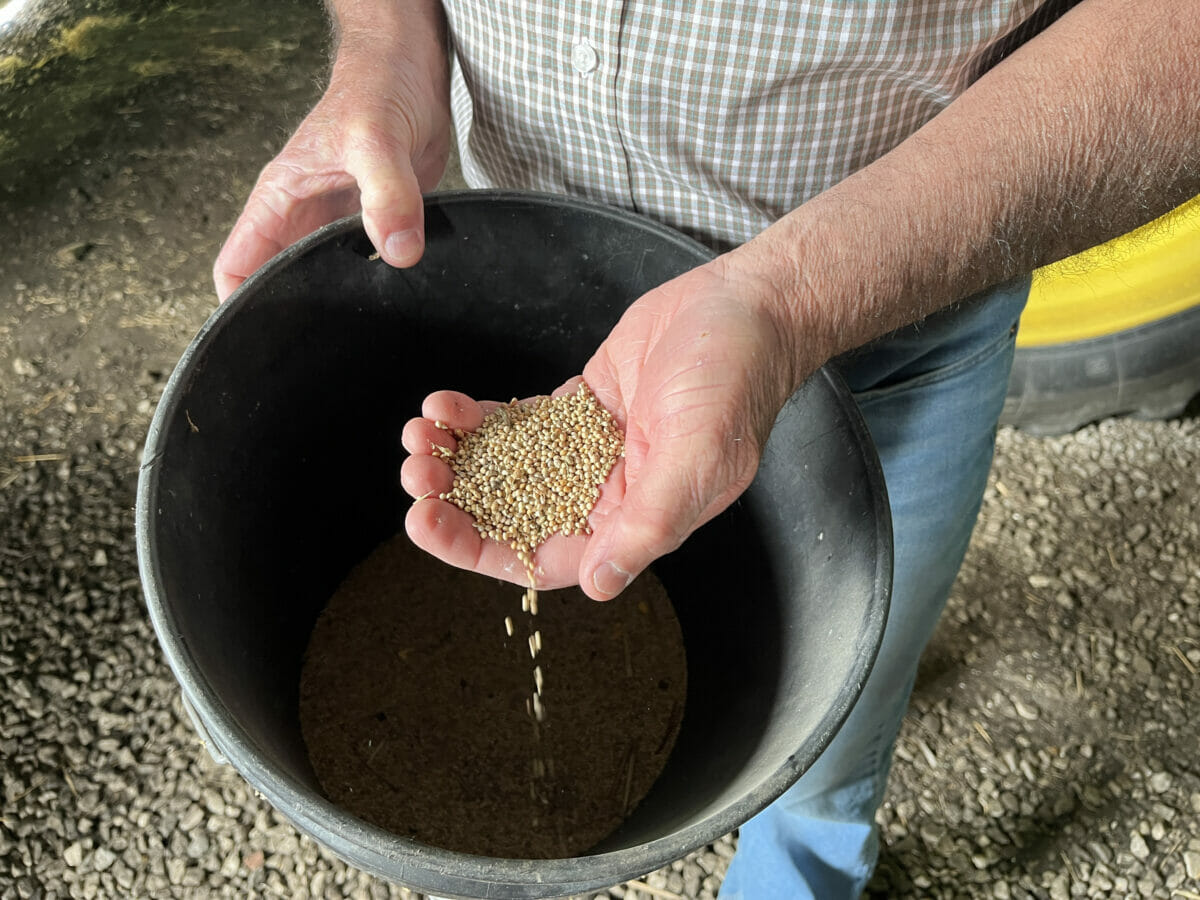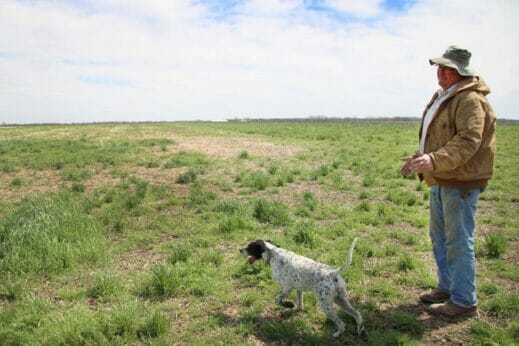Though millet is sustainable, weather resilient, and nutritious, it has not gotten nearly the same level of US policy and research attention compared to corn and soybeans.

The Midwest is known for its rows and rows of corn and soybeans that uniformly cover the landscape.
But in central Missouri, farmer Linus Rothermich disrupts the usual corn and soybean rotation with Japanese millet. He has been growing it since 1993.
“Golly, I have to think how far back that is,” he said. “I was a young man and I was looking for alternative crops to grow to make more money. We just weren’t making a lot of money in agriculture then.”
Compared to his corn and soybean crops, he spends a lot less on Japanese millet. Because its growing season is shorter, it fits perfectly into the rotation of the crops he already grows. It’s working so well for him that he wants to keep the grain to himself.
“I have recommended it to other farmers, as long as it’s not my Japanese millet,” he joked, pointing out prices likely would drop if a lot of other farmers start growing it.
But these humble grains soon may garner more attention after the United Nations declared 2023 the International Year of Millets. It’s part of an effort to encourage more awareness and a bigger market for millets, which the UN points out are extremely sustainable, weather resilient, nutritious and could help diversify the global food system.
However, the grains have not gotten nearly the same level of policy and research attention compared to corn and soybeans in the United States, or even compared to other crops in the global market.
“Millets had gotten sort of marginalized in its place, and therefore, it didn’t get the same investment and research attention that maize, wheat and rice have received over the last decades,” said Makiko Taguchi, an agricultural officer at the UN’s Food and Agriculture Organization, “so in that sense we consider millets as one of the sort of neglected crops.”
She said that millets have an opportunity to assist with the United Nations’ Sustainable Development Goals and that hopefully will bring these climate-friendly grains more attention – similar to the success of the UN’s International Year of Quinoa in 2013.
A climate-friendly crop
There are several different kinds of millets. In addition to Rothermich’s Japanese millet, there is pearl millet, foxtail millet, proso millet and more. Sorghum can also be considered a millet.
Millets tend to need less fertilizer and are more resistant to insects and diseases (although sometimes birds like to eat them). Farmers can also use most of the same equipment for millets as they do for corn and soybeans. And while, so far, millets don’t produce the same yields as those commodity crops, Rothermich says it’s worth it.
“It’s not as high-yielding, but it also has lower inputs on it,” he said.

Linus Rothermich on the field where he plans on planting this year’s crop of Japanese millet. He grows the crop for seeds that are sold and planted elsewhere to support waterfowl populations. (Photo: Eva Tesfaye/Harvest Public Media)
Perhaps more important today in parts of the Midwest and Great Plains, many types of millets are known to be incredibly drought resistant.
Matt Little, a farmer just outside of Arnett, Oklahoma, started growing proso millet last year. He expected the crop to burn up alongside his wheat crop during the extreme heat and the drought, but he managed to harvest and sell the crop.
“I’m really impressed with it. I’ve never seen a crop that stood the heat and stood the drought and still made me money,” he said.
Millets are also getting attention at the University of Missouri’s Center for Regenerative Agriculture, which is providing information to farmers on the grains.
The center’s director, Rob Myers, said that millets are versatile. Proso and pearl millet would do well in drier states like Nebraska, Kansas, Oklahoma and Texas.
Japanese millet survives hot humid conditions and is often used for planting in creek bottoms to support wildlife.
“We see millets being used in some of those areas because of concerns about the supply of irrigation water,” he said.
Other millets would be better in places that are prone to flooding like the Missouri and Mississippi River bottoms. That includes the Japanese millet Rothermich grows in Missouri.
The market for millets is not a large one in the United States, except for its use as songbird seed. However, millets could be used for livestock feed, cover crops and even biofuels. Myers said that they could even become a more popular food option as people look for gluten-free alternatives.
“I expect the market opportunities to continue to expand, but it’ll be incremental,” said Myers.
Research and policy investment
Because the market is not as large, millets are not as well-known as other crops in the United States.
Ram Perumal, the head of Kansas State University’s millet breeding program, said millets don’t get the same level of federal protection as corn and soybeans.
“Those are all cash crops: They have insurance; the prices; the market is there; commodity grant support is there,” he said.
While there is insurance available for proso millet, it is only available in certain parts of the country. Perumal said that lack of support and protection also makes it harder to get research grants. He’s hoping the UN Year of Millets will help highlight the importance of millet science.
More research is needed to really advance millets, said Myers of the University of Missouri.
“If you spend an extra $1 million on corn research, you don’t necessarily advance the state of corn science very much,” he said, “but if you spent a million dollars on millet research, you might suddenly create a whole lot of new information that we didn’t have before.”
For example, millet yields would be easier to improve than getting corn to take up less water, according to James Schnable, a professor at the University of Nebraska. He and his father, Patrick Schnable, a professor at Iowa State University, co-founded the start-up, Dryland Genetics. A lack of funding for research is partly why they started a company to research and breed proso millet.
“(Proso millet) is in this weird hole in the federal funding schemes, which is part of why we ended up using private money to start Dryland Genetics. Because it’s a grain, it doesn’t qualify for a lot of the specialty crop grants,” said James Schnable.
Farmer Jeff Taylor started growing proso millet on his farm outside of Ames, Iowa, around six years ago. He uses much of the same equipment that he uses for his corn crop.
In Ames, Iowa, farmer Jeff Taylor said he started growing proso millet about six years ago, with the help of Dryland Genetics. He thinks more farmers would try new crops if federal programs would shoulder some of the risk.
“It would be wonderful if crops like proso millet were researched more and there were some incentives for farmers to consider planting alternative crops outside of just corn and soybeans,” he said.
This story was produced by Harvest Public Media, a collaboration of public media newsrooms in the Midwest, and the Mississippi River Basin Ag & Water Desk, an editorially independent reporting network based at the University of Missouri in partnership with Report For America.